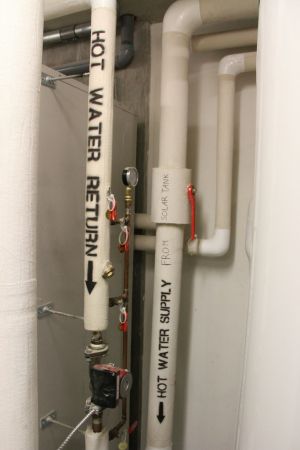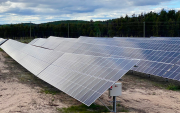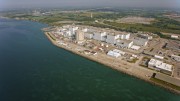I had the privilege to spend some time a few weeks ago at the Canadian Geothermal Energy Association’s annual conference, where one participant described geothermal as Canada’s ‘have not’ renewable energy industry.
The 'have not' label is appropriate, since there are no existing commercial geothermal electricity projects in Canada, and limited to no geothermal-specific government support. Where Canadian geothermal companies have been successful is, surprisingly, everywhere but Canada.
Globally, interest in geothermal energy has never been higher. As of 2013 there were roughly 12 GW of geothermal energy being produced annually, and an additional 12 GW of projects at various states of development in over 70 countries. A gigawatt of power is roughly enough power for a million homes, and roughly the scale of one major coal-fired power plant. One source suggests that the international geothermal industry will add 0.5-1 GW of capacity per year for the rest of this decade. In 2013, an all-star cast of scientists, business people and policy wonks gathered by the University of Waterloo’s Global Science Initiative identified geothermal energy as one of its five “pillars” for achieving a more sustainable energy future and avoiding the worst impacts of global climate change.
What about here in Canada? The U.S. leads the world in installed capacity (including in Alaska), with Mexico fourth in line. Yet while “geology doesn’t change at the 49th parallel” — a frequent refrain at the CanGEA conference — the number of Canadian geothermal power projects in operation is stubbornly stuck at zero. Two of the biggest factors keeping the industry dormant include the high upfront cost and risk, and the lack of commercial power plants in Canada, critical for proving viability of the sector.
The skills necessary for success in geothermal parallel those of the oil and gas sector and are here in abundance: subsurface exploration, drilling, and project finance — a fact the Pembina Institute documented at length in our study of renewables investment by the oil and gas sector. In fact, in Alberta we have not only some of the best-understood subsurface geology in the world thanks to the 400,000 or so wells the industry has drilled, but also some of the world’s richest experience managing subsurface heat thanks to numerous thermal oilsands recovery projects. Deep geothermal resources are widely tapped for direct uses including bathing and fish processing, at sites including the iconic hot springs of British Columbia and Banff, as well as in Saskatchewan, the Yukon, and the Northwest Territories.
 Furthermore, a geopower demonstration project was run at Meager Creek near Whistler and another pilot project is in its planning phases for southern Saskatchewan. In 2013 CanGEA produced a technology roadmap and implementation plan to help overcome some of the technical impediments to the growth of the sector.
Furthermore, a geopower demonstration project was run at Meager Creek near Whistler and another pilot project is in its planning phases for southern Saskatchewan. In 2013 CanGEA produced a technology roadmap and implementation plan to help overcome some of the technical impediments to the growth of the sector.
Deep and near-surface geothermal heat potential in Alberta has recently been assessed to international standards. Unsurprisingly, the theoretical potential is vast, the technical potential similarly so. The lack of commercial geothermal power projects on our side of the border — in spite of the proven potential — suggests a real chicken-and-egg problem, and a real business opportunity.
Challenges that experts at the conference flagged include gaps in the policy framework (undefined rights to the subsurface heat or poorly-designed right acquisition process), the hodgepodge of regulatory and market structures across the country, historically-cheap natural gas, and of course the absence of a meaningful price on carbon emissions that would encourage a shift to lower-carbon alternatives.
Areas where the industry can help itself include improving the probability of successful projects through better subsurface mapping, harnessing innovative financial models like those that are powering the boom in solar, establishing an offset protocol in Alberta to enable monetization of green attributes, and most importantly, through driving costs down across the supply chain and in project execution. With a reported 292 remote “off-grid” communities in Canada, at least two thirds of whom rely on trucked-in diesel and propane for power, renewables including geothermal would seem to be a natural fit where the resource is available. But these so-called “island economics” help on one side while hurting on the other: remote settings make execution more complex and prone to exponential escalation of cost.
The critical absence of government support can and should be resolved. In addition to a meaningful carbon price, options include government loan guarantees, favourable tax structures (accelerated capital depreciation was critical to launch of the oilsands, for example), conversion of tax incentives to upfront grants, and government-backed funds for drilling and exploration risk insurance.
Sound challenging? You have all the potential risks of oil and gas development combined with utility rates of return. Clearly there is a need for public support to pilot the first projects, public science to identify the best resources and the ones most accessible from the existing grid, and public-private partnerships of the type exemplified by the Alberta CCS Advisory Panel to advance Enhanced Geothermal Systems in Canada.
The good news: necessity is the mother of invention. To fund its work on government relations and policy development, CanGEA bypassed government handouts and cleverly went to Indiegogo for crowdfunding. This can-do atmosphere pervaded the conference. One presenter, Doris Weis, has made investigation of geothermal opportunities in the Canadian oil patch the focus of a half a decade of work. Thanks to her hard work, it looks as if at least one operator is seriously considering waste heat recovery at one of its heavy oil projects. Her ringing takeaway line summarized the conference and work of CanGEA: “If we work as a team, we can improve the technologies and make this industry a success.”







